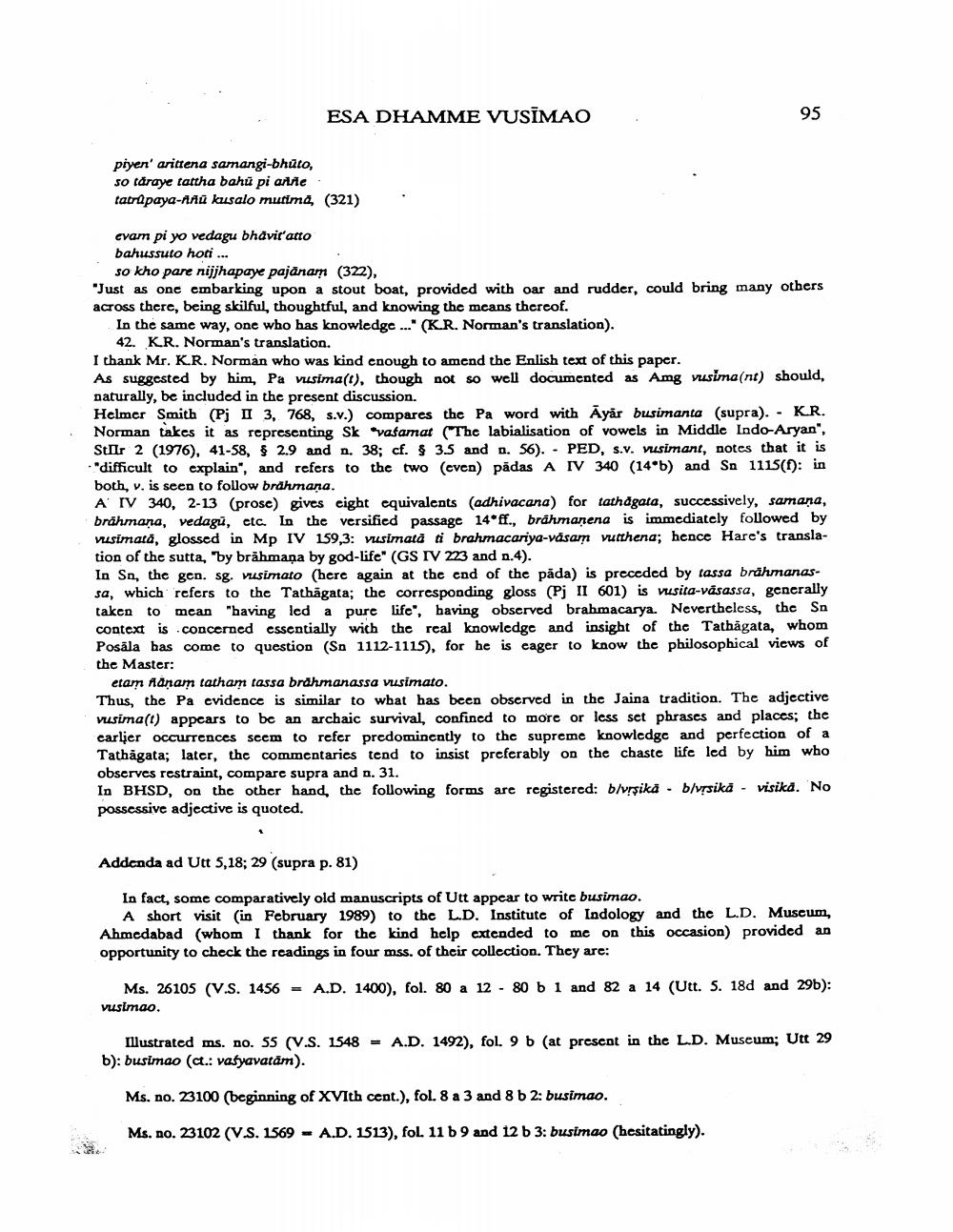________________
ESA DHAMME VUSĪMAO
piyen' arittena samangi-bhūto, so taraye tattha bahu pi aññe tatrûpaya-ññû kusalo mutima, (321)
evam pi yo vedagu bhaviť'atto
bahussuto hoti...
so kho pare nijjhapaye pajānam (322),
"Just as one embarking upon a stout boat, provided with oar and rudder, could bring many others across there, being skilful, thoughtful, and knowing the means thereof.
In the same way, one who has knowledge..." (K.R. Norman's translation).
42. K.R. Norman's translation.
95
I thank Mr. K.R. Norman who was kind enough to amend the Enlish text of this paper.
As suggested by him, Pa vusima(t), though not so well documented as Amg vusima (nt) should, naturally, be included in the present discussion.
Helmer Smith (Pj II 3, 768, s.v.) compares the Pa word with Ayar busimanta (supra). KR. Norman takes it as representing Sk vasamat (The labialisation of vowels in Middle Indo-Aryan", Str 2 (1976), 41-58, § 2.9 and n. 38; cf. § 3.5 and n. 56). PED, s.v. vusimant, notes that it is "difficult to explain", and refers to the two (even) pādas A IV 340 (14 b) and Sn 1115(f): in both, v. is seen to follow brāhmaṇa.
·
A IV 340, 2-13 (prose) gives eight equivalents (adhivacana) for tathagata, successively, samana, brahmana, vedagi, etc. In the versified passage 14 ff., brahmanena is immediately followed by vusimată, glossed in Mp IV 159,3: vusimatà ti brahmacariya-vasam vutthena; hence Hare's translation of the sutta, "by brāhmaṇa by god-life" (GS IV 223 and n.4).
In Sn, the gen. sg. vusimato (here again at the end of the päda) is preceded by tassa brahmanassa, which refers to the Tathāgata; the corresponding gloss (Pj II 601) is vusita-vāsassa, generally taken to mean "having led a pure life", having observed brahmacarya. Nevertheless, the Sn context is concerned essentially with the real knowledge and insight of the Tathāgata, whom Posāla has come to question (Sn 1112-1115), for he is eager to know the philosophical views of the Master:
etam Aanam tatham tassa brahmanassa vusimato.
Thus, the Pa evidence is similar to what has been observed in the Jaina tradition. The adjective vusima(t) appears to be an archaic survival, confined to more or less set phrases and places; the earlier occurrences seem to refer predominently to the supreme knowledge and perfection of a Tathāgata; later, the commentaries tend to insist preferably on the chaste life led by him who observes restraint, compare supra and n. 31.
In BHSD, on the other hand, the following forms are registered: b/vṛşikä blvṛsikä visikā. No possessive adjective is quoted.
Addenda ad Utt 5,18; 29 (supra p. 81)
In fact, some comparatively old manuscripts of Utt appear to write busimao.
A short visit (in February 1989) to the LD. Institute of Indology and the L.D. Museum, Ahmedabad (whom I thank for the kind help extended to me on this occasion) provided an opportunity to check the readings in four mss. of their collection. They are:
-
Ms. 26105 (V.S. 1456 = A.D. 1400), fol. 80 a 12 80 b 1 and 82 a 14 (Utt. 5. 18d and 29b): vusimao.
Illustrated ms. no. 55 (V.S. 1548 A.D. 1492), fol. 9 b (at present in the L.D. Museum; Utt 29 b): busimao (ct.: varyavatām).
Ms. no. 23100 (beginning of XVIth cent.), fol. 8 a 3 and 8 b 2: busimao.
Ms. no. 23102 (V.S. 1569 A.D. 1513), fol. 11 b 9 and 12 b 3: busimao (hesitatingly).




